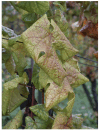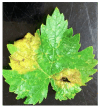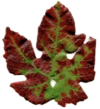Artificial Intelligence Techniques in Grapevine Research: A Comparative Study with an Extensive Review of Datasets, Diseases, and Techniques Evaluation
- PMID: 39409251
- PMCID: PMC11479125
- DOI: 10.3390/s24196211
Artificial Intelligence Techniques in Grapevine Research: A Comparative Study with an Extensive Review of Datasets, Diseases, and Techniques Evaluation
Abstract
In the last few years, the agricultural field has undergone a digital transformation, incorporating artificial intelligence systems to make good employment of the growing volume of data from various sources and derive value from it. Within artificial intelligence, Machine Learning is a powerful tool for confronting the numerous challenges of developing knowledge-based farming systems. This study aims to comprehensively review the current scientific literature from 2017 to 2023, emphasizing Machine Learning in agriculture, especially viticulture, to detect and predict grape infections. Most of these studies (88%) were conducted within the last five years. A variety of Machine Learning algorithms were used, with those belonging to the Neural Networks (especially Convolutional Neural Networks) standing out as having the best results most of the time. Out of the list of diseases, the ones most researched were Grapevine Yellow, Flavescence Dorée, Esca, Downy mildew, Leafroll, Pierce's, and Root Rot. Also, some other fields were studied, namely Water Management, plant deficiencies, and classification. Because of the difficulty of the topic, we collected all datasets that were available about grapevines, and we described each dataset with the type of data (e.g., statistical, images, type of images), along with the number of images where they were mentioned. This work provides a unique source of information for a general audience comprising AI researchers, agricultural scientists, wine grape growers, and policymakers. Among others, its outcomes could be effective in curbing diseases in viticulture, which in turn will drive sustainable gains and boost success. Additionally, it could help build resilience in related farming industries such as winemaking.
Keywords: artificial intelligence; diseases; grapevine; machine learning; smart agriculture; smart sensors; vineyards.
Conflict of interest statement
The authors declare no conflicts of interest.
Figures
















Similar articles
-
Grape dataset: A dataset for disease prediction and classification for machine learning applications through environmental parameters.Data Brief. 2024 May 21;54:110546. doi: 10.1016/j.dib.2024.110546. eCollection 2024 Jun. Data Brief. 2024. PMID: 38912421 Free PMC article.
-
Automatic Detection of Flavescence Dorée Symptoms Across White Grapevine Varieties Using Deep Learning.Front Artif Intell. 2020 Nov 30;3:564878. doi: 10.3389/frai.2020.564878. eCollection 2020. Front Artif Intell. 2020. PMID: 33733210 Free PMC article.
-
Rapid Determination of Wine Grape Maturity Level from pH, Titratable Acidity, and Sugar Content Using Non-Destructive In Situ Infrared Spectroscopy and Multi-Head Attention Convolutional Neural Networks.Sensors (Basel). 2023 Nov 30;23(23):9536. doi: 10.3390/s23239536. Sensors (Basel). 2023. PMID: 38067909 Free PMC article.
-
Machine Learning in Agriculture: A Comprehensive Updated Review.Sensors (Basel). 2021 May 28;21(11):3758. doi: 10.3390/s21113758. Sensors (Basel). 2021. PMID: 34071553 Free PMC article. Review.
-
A review on utilizing machine learning technology in the fields of electronic emergency triage and patient priority systems in telemedicine: Coherent taxonomy, motivations, open research challenges and recommendations for intelligent future work.Comput Methods Programs Biomed. 2021 Sep;209:106357. doi: 10.1016/j.cmpb.2021.106357. Epub 2021 Aug 16. Comput Methods Programs Biomed. 2021. PMID: 34438223 Review.
Cited by
-
Smart Chip Technology for the Control and Management of Invasive Plant Species: A Review.Plants (Basel). 2025 May 18;14(10):1510. doi: 10.3390/plants14101510. Plants (Basel). 2025. PMID: 40431075 Free PMC article. Review.
-
A Novel Hybrid Technique for Detecting and Classifying Hyperspectral Images of Tomato Fungal Diseases Based on Deep Feature Extraction and Manhattan Distance.Sensors (Basel). 2025 Jul 9;25(14):4285. doi: 10.3390/s25144285. Sensors (Basel). 2025. PMID: 40732413 Free PMC article.
References
-
- Mourtzis D., Angelopoulos J., Panopoulos N. A Literature Review of the Challenges and Opportunities of the Transition from Industry 4.0 to Society 5.0. Energies. 2022;15:6276. doi: 10.3390/en15176276. - DOI
-
- Vishnoi V.K., Kumar K., Kumar B. Plant disease detection using computational intelligence and image processing. J. Plant Dis. Prot. 2021;128:19–53. doi: 10.1007/s41348-020-00368-0. - DOI
-
- Abdulridha J., Batuman O., Ampatzidis Y. UAV-based remote sensing technique to detect citrus canker disease utilizing hyperspectral imaging and Machine Learning. Remote Sens. 2019;11:1373. doi: 10.3390/rs11111373. - DOI
-
- Ouhami M., Hafiane A., Es-Saady Y., El Hajji M., Canals R. Computer vision, IoT and data fusion for crop disease detection using Machine Learning: A survey and ongoing research. Remote Sens. 2021;13:2486. doi: 10.3390/rs13132486. - DOI
Publication types
MeSH terms
LinkOut - more resources
Full Text Sources

